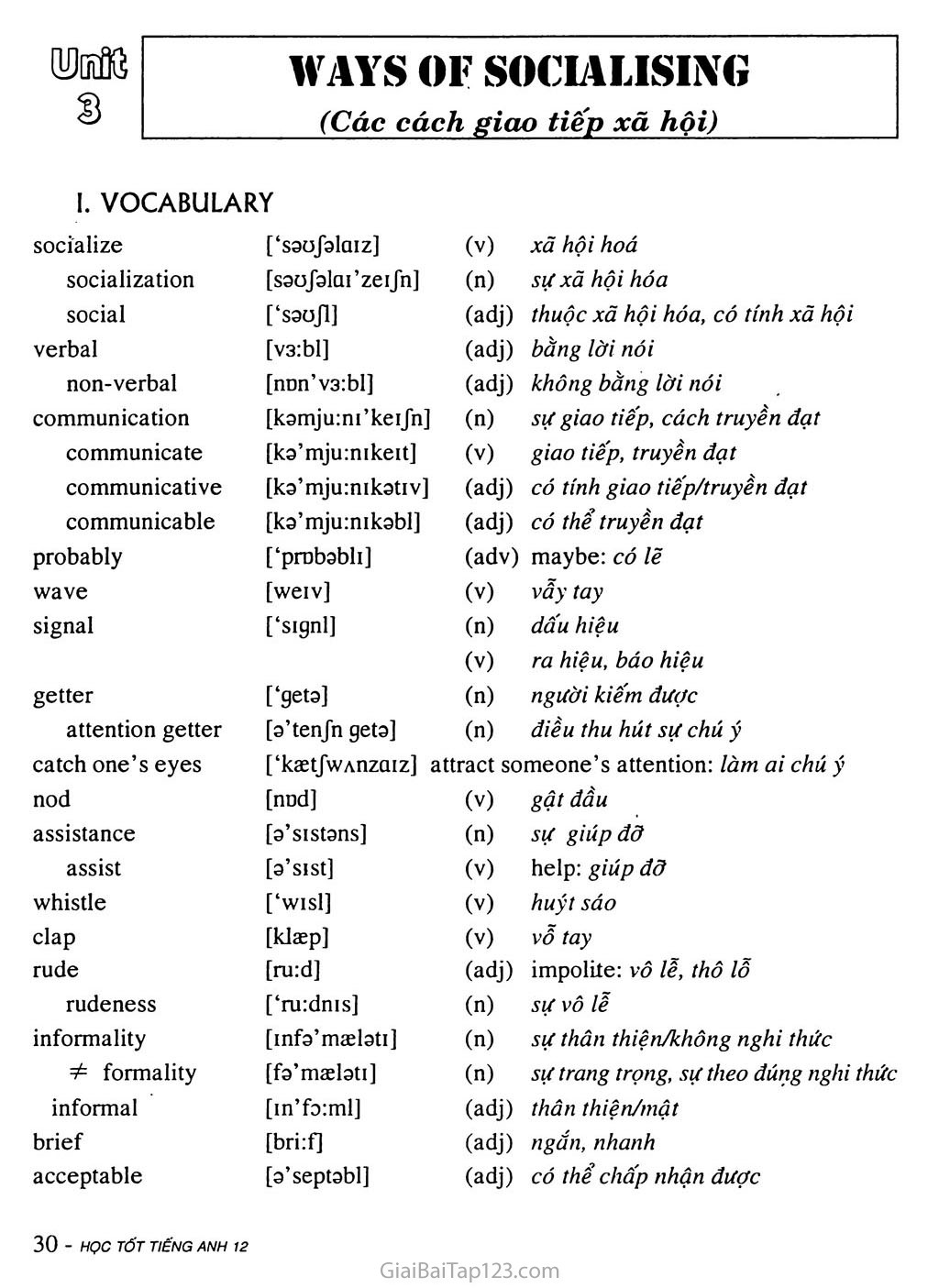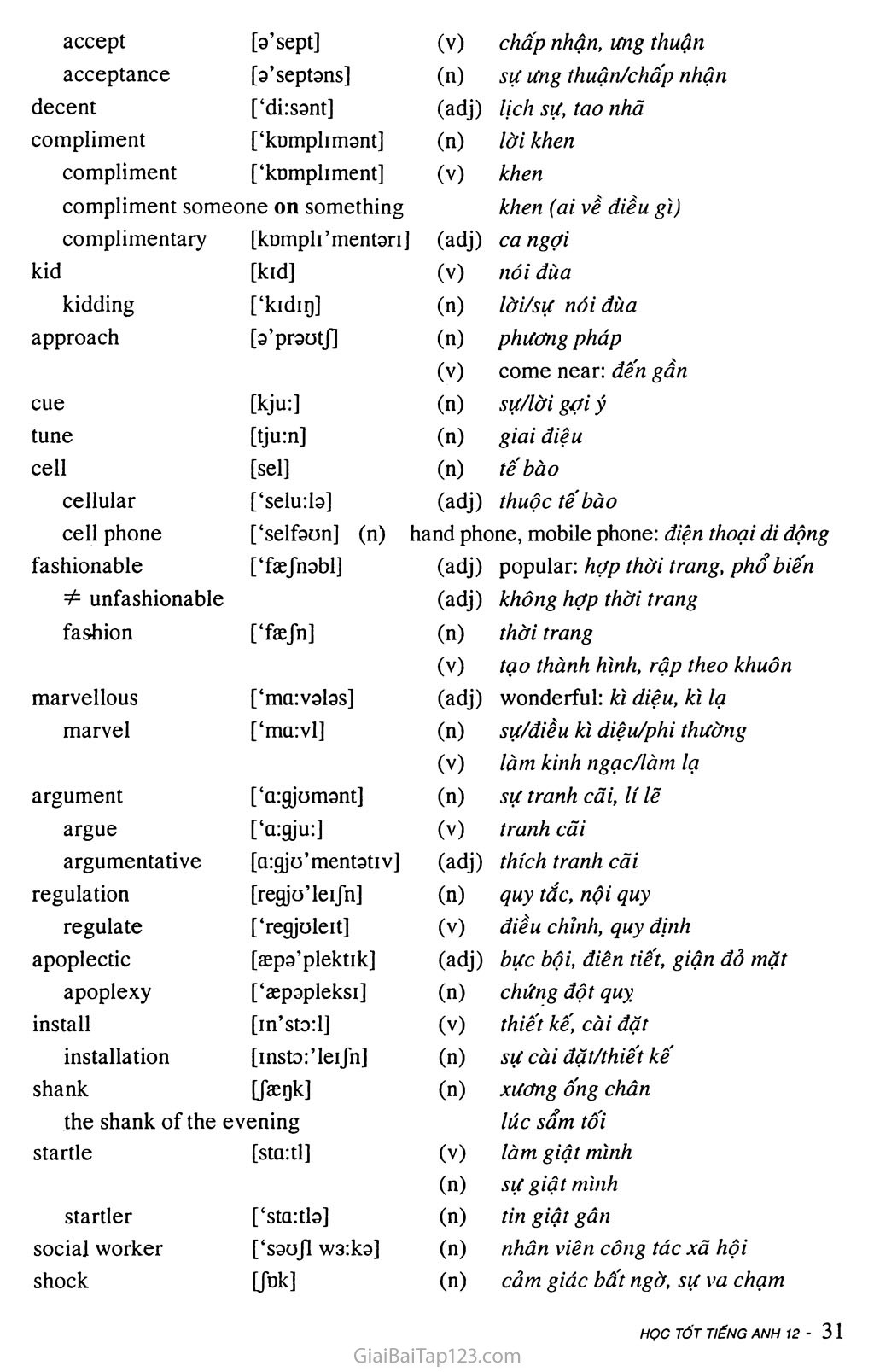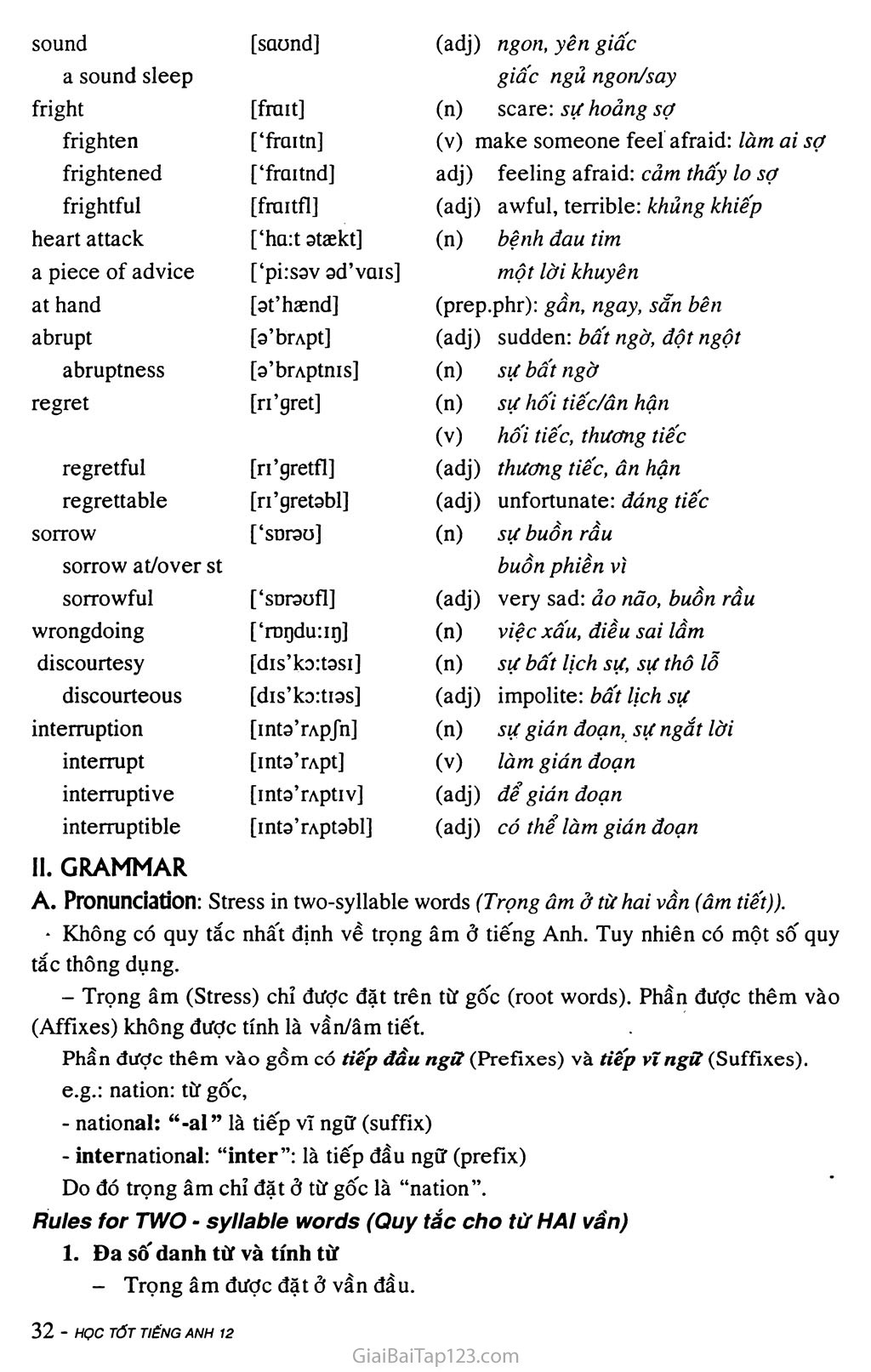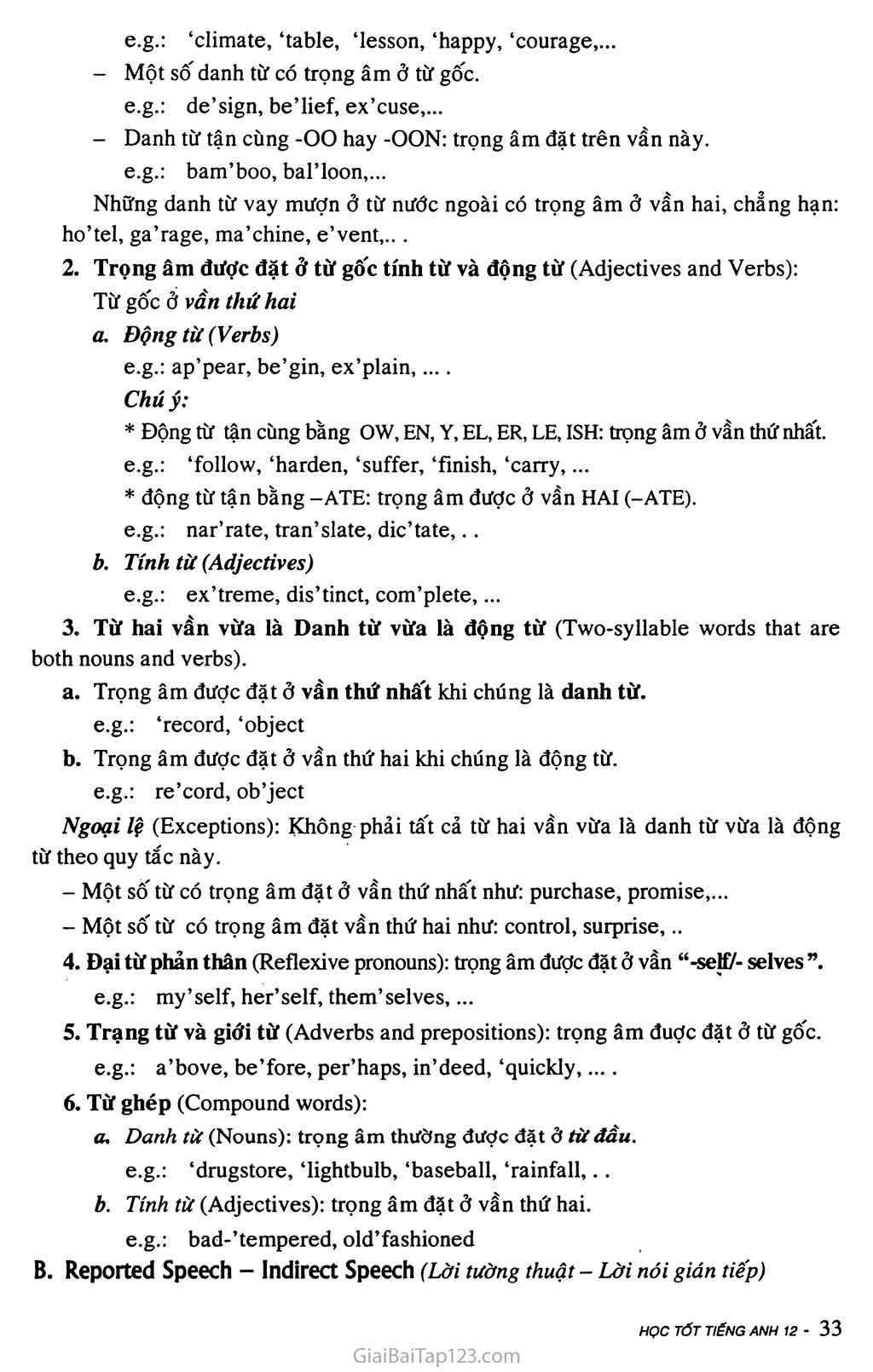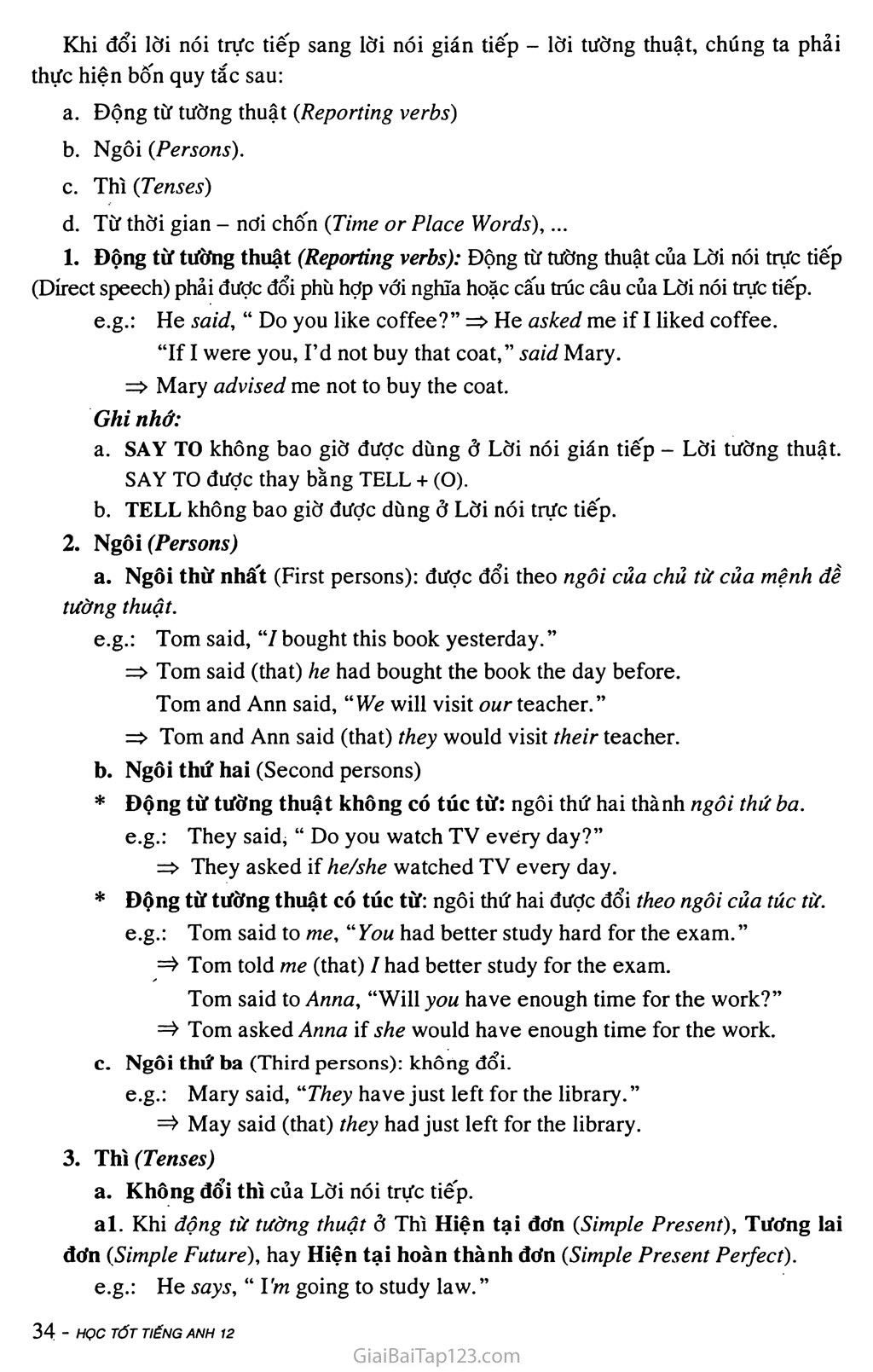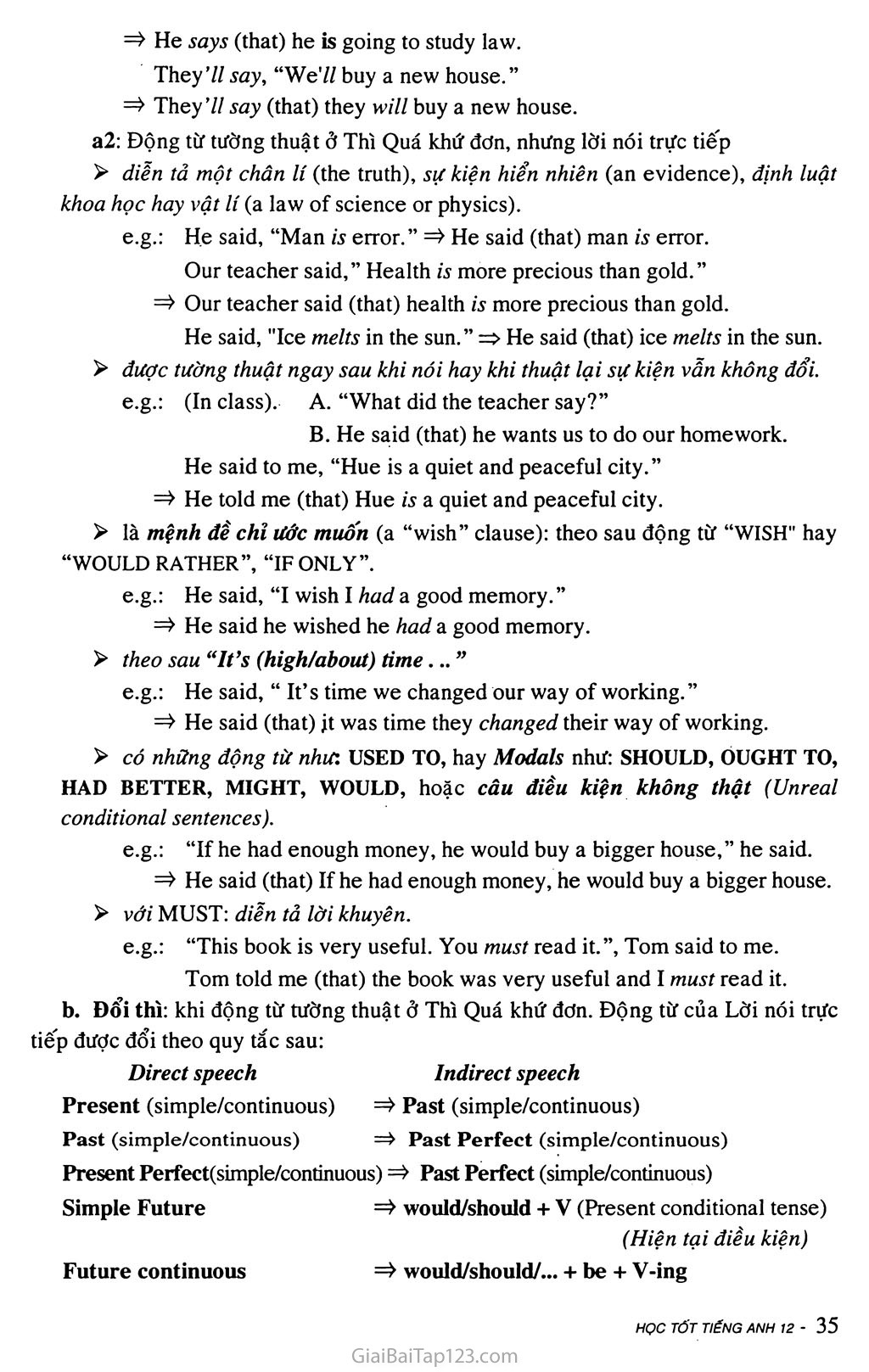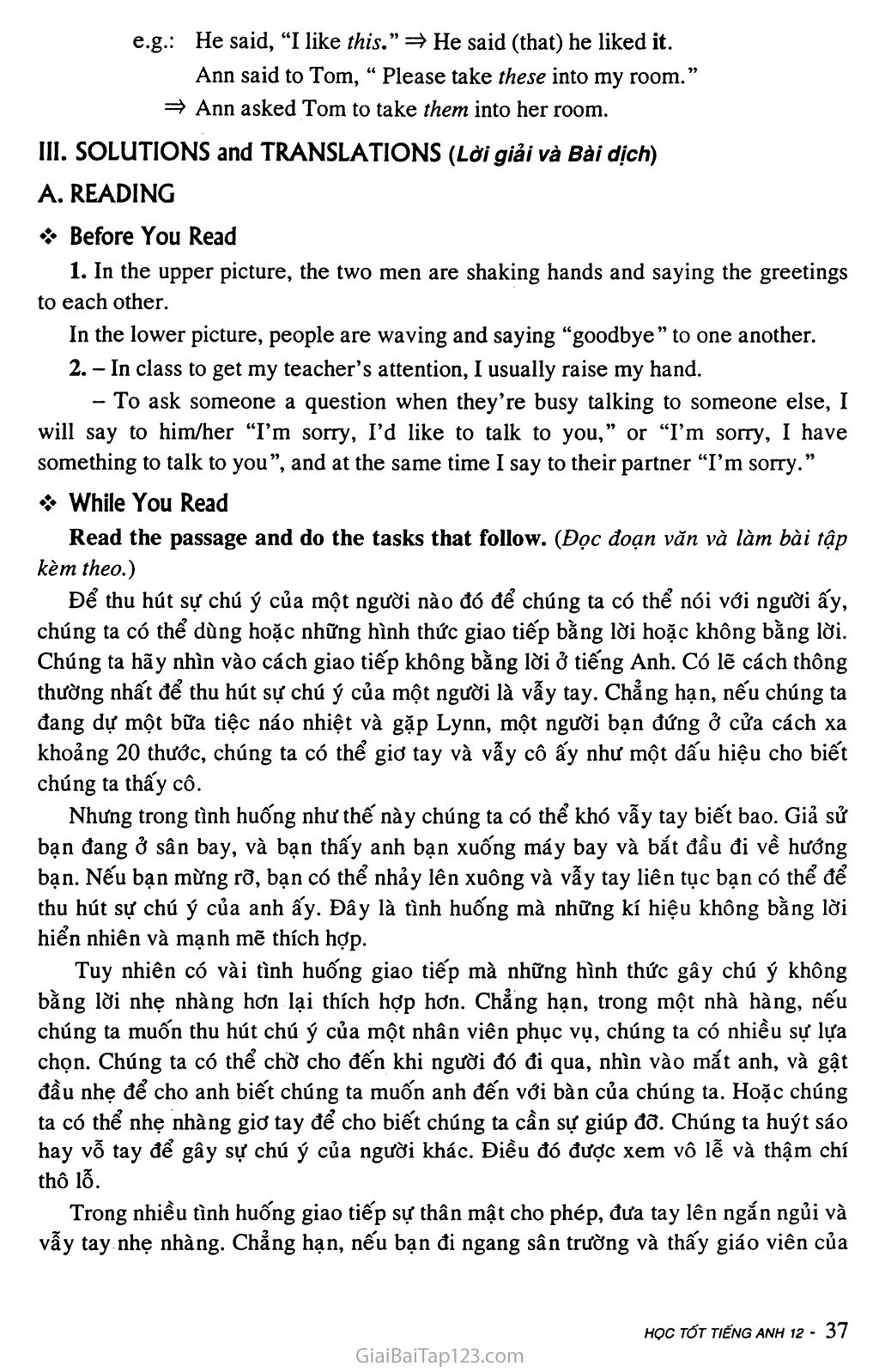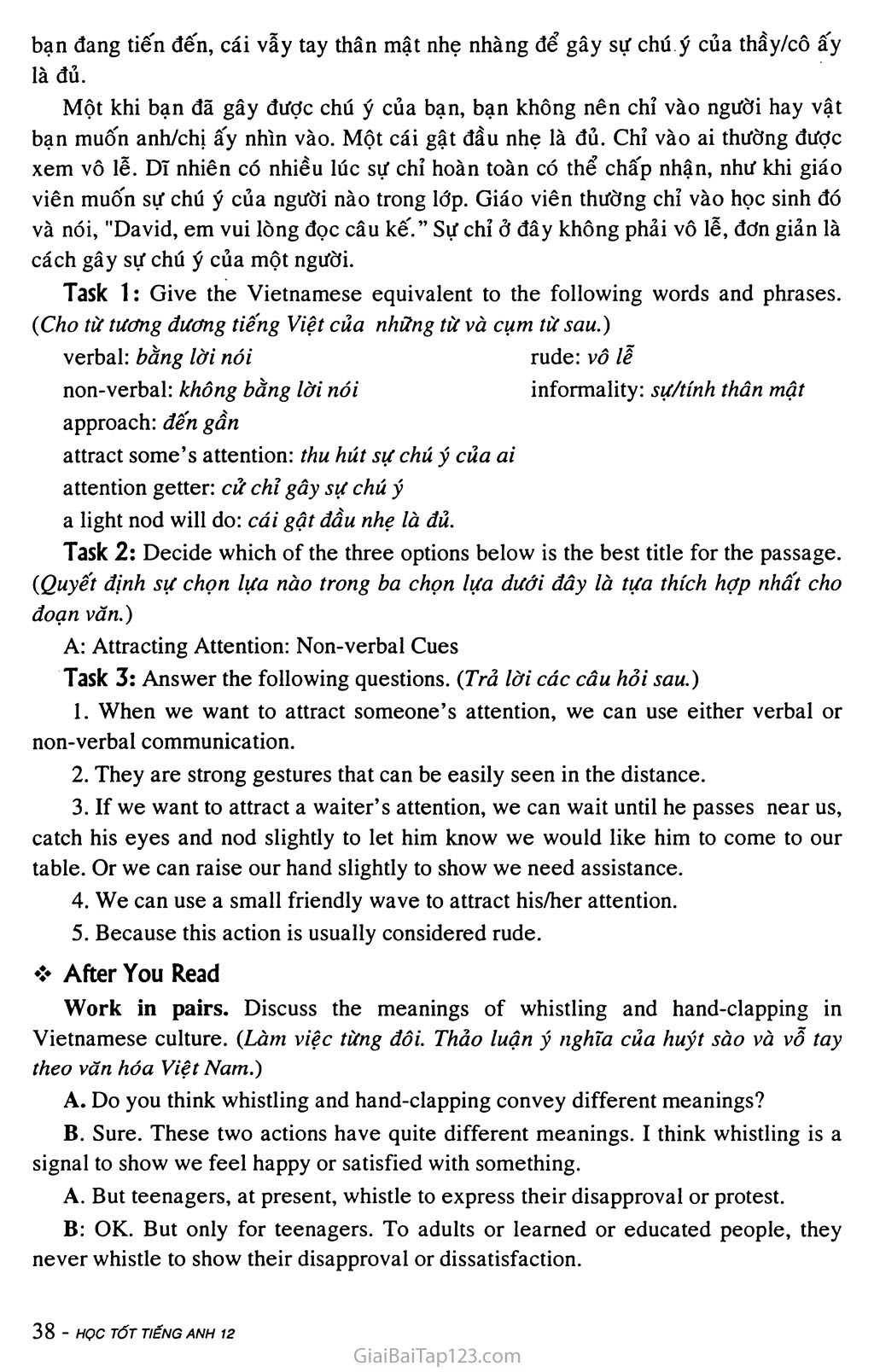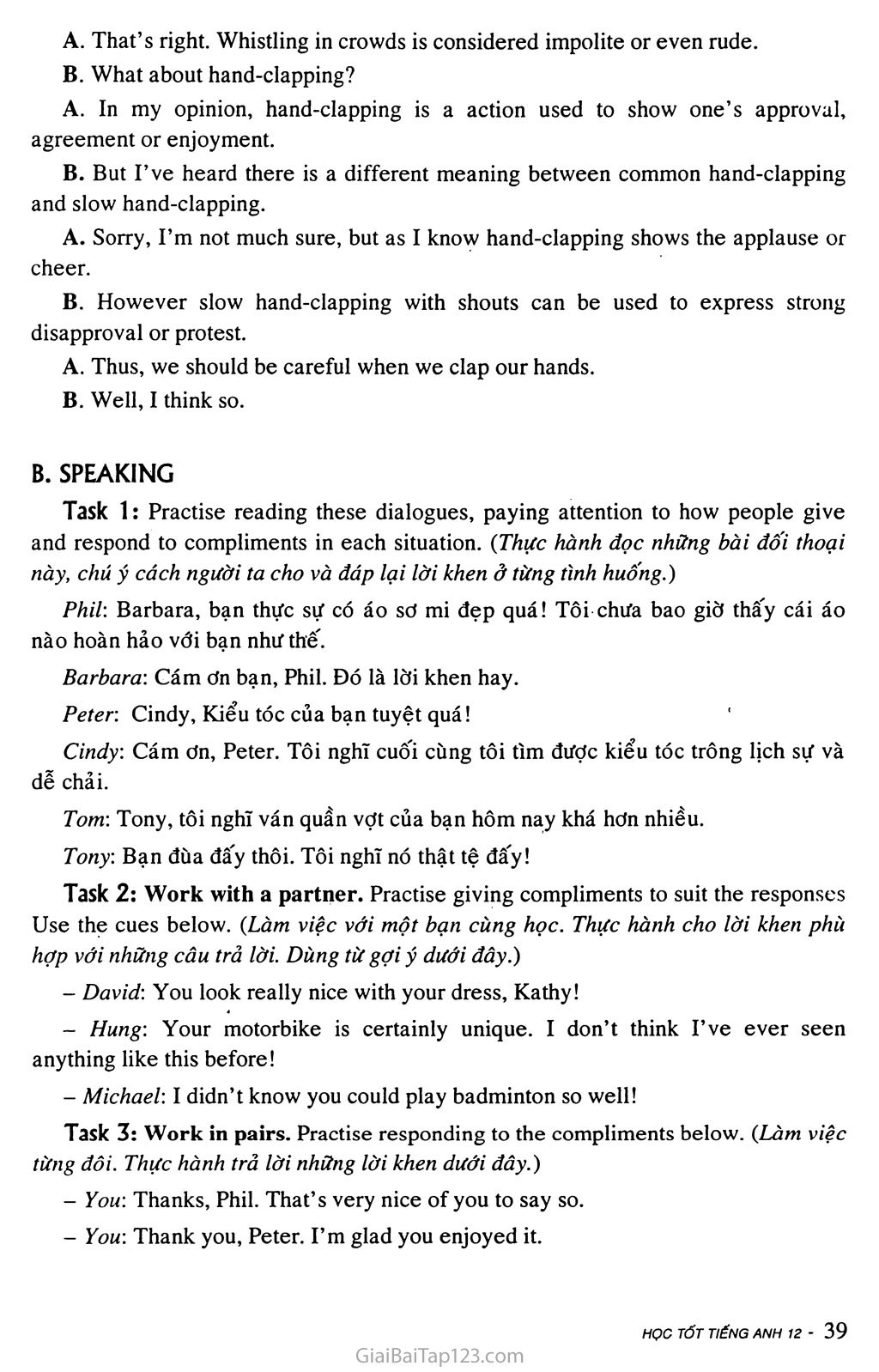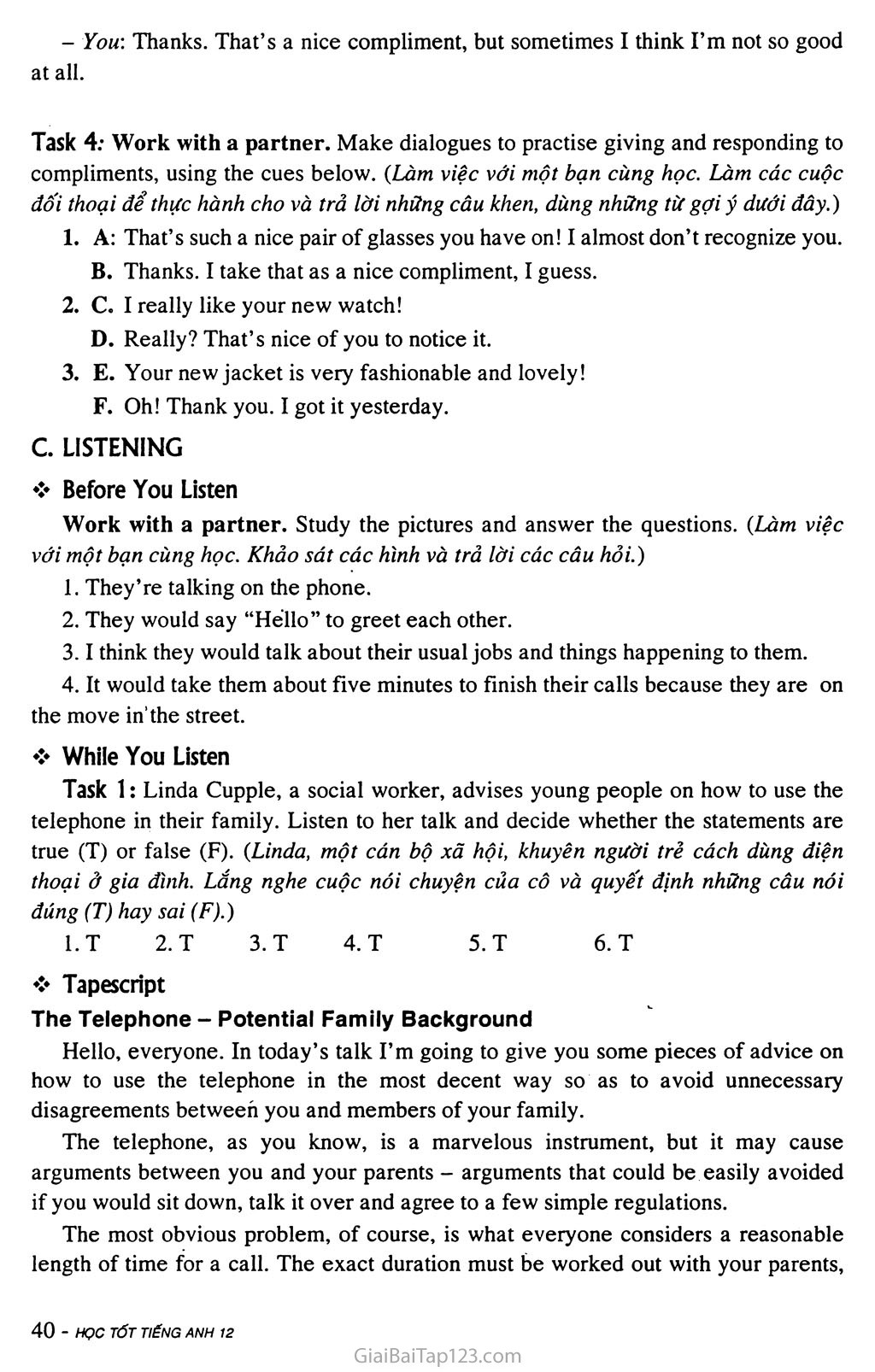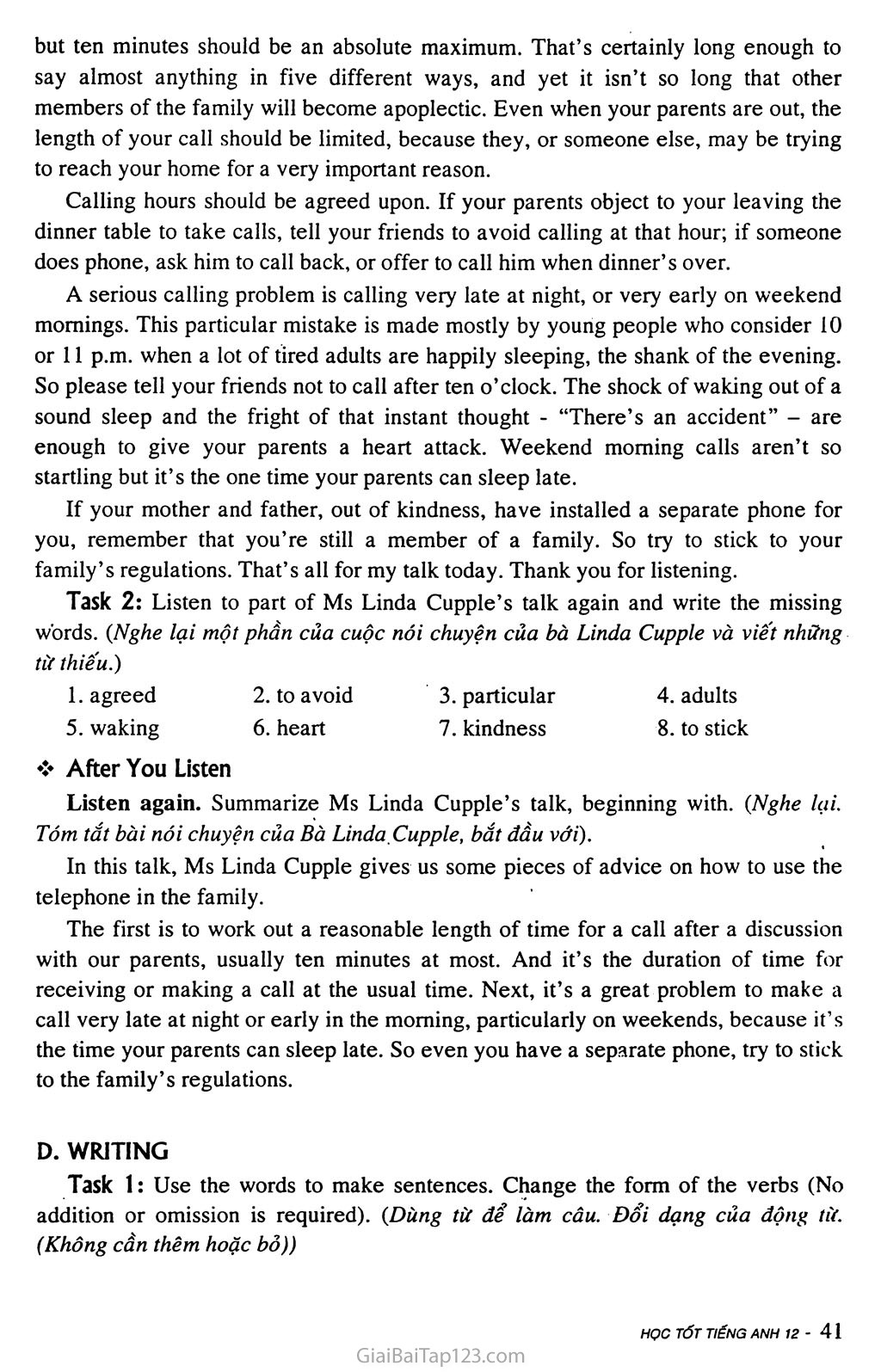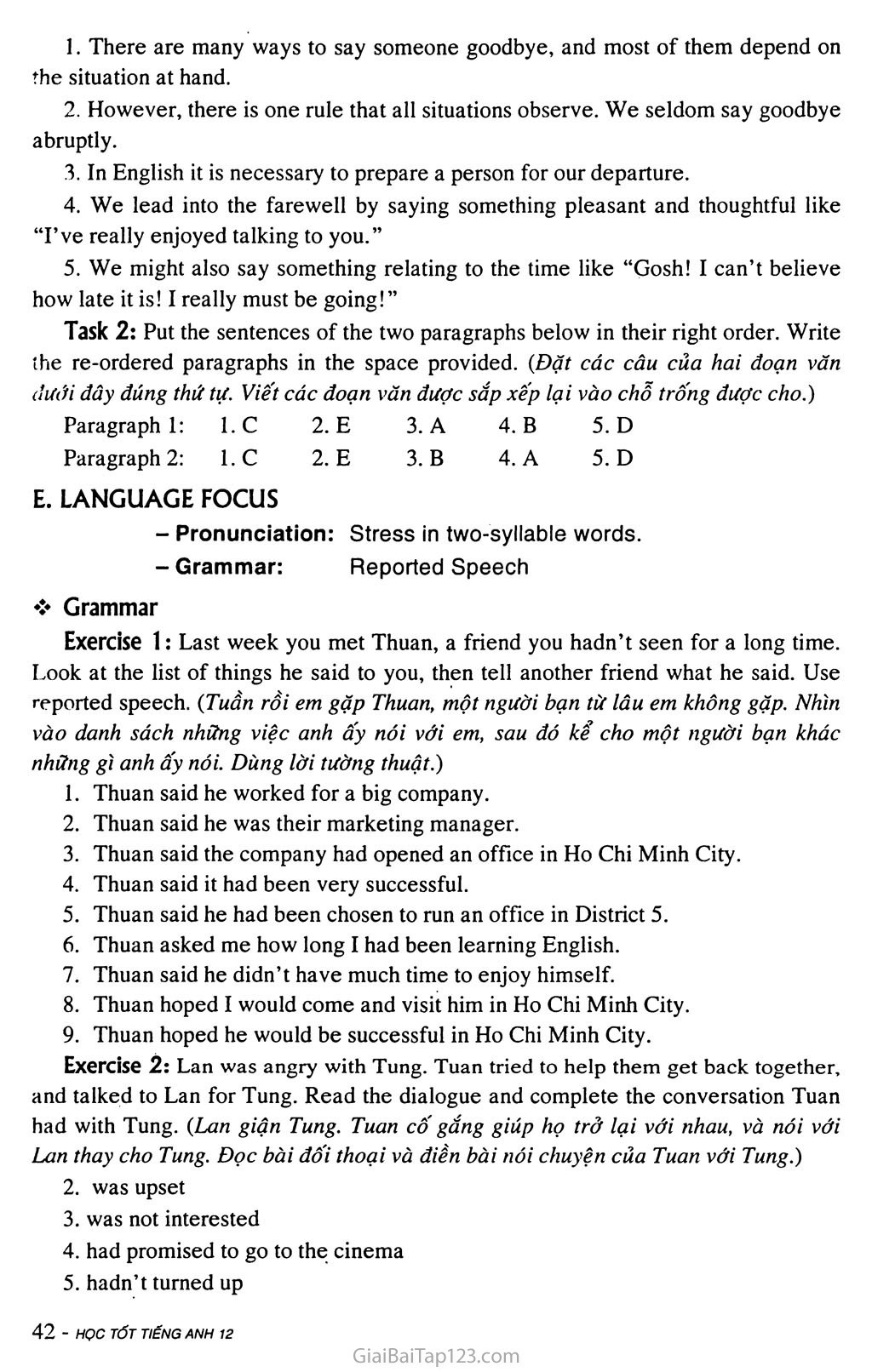Giải tiếng Anh lớp 12 Unit 3: WAVS OF SOCIALISING
WAYS OF SOCIALISING
(Các cách giao tiếp xã hội)
I. VOCABULARY
socialize
[‘saojalaiz]
(V)
xã hộihoá
socialization
[saojolai’zeijn]
(n)
sự xã hội hóa
social
[‘soojl]
(adj)
thuộc xã hội hóa, có tính xã hội
verbal
[V3:bl]
(adj)
bằng lời nói
non-verbal
[nDn’v3:bl]
(adj)
không bằng lời nói
communication
[komjumi’keijn]
(n)
sự giao tiếp, cách truyền đạt
communicate
[ko’mjumikeit]
(V)
giao tiếp, truyền đạt
communicative
[ko’mjumikotiv]
(adj)
có tính giao tiếp/truyền đạt
communicable
[ko’mjumikobl]
(adj)
có thể truyền đạt
probably
[‘probobli]
(adv)
maybe: có lẽ
wave
[weiv]
(V)
vẫy tay
signal
[‘signl]
(n)
(V)
dấu hiệu ra hiệu, báo hiệu
getter
[‘gets]
(n)
người kiếm được
attention getter
[o’tenjn gets]
(n)
điều thu hút sự chú ý
catch one’s eyes
[‘kastJwAnzaiz] attract someone’s attention: làm ai chú ý
nod
[nt)d]
(V)
gật đầu
assistance
[a’sistans]
(n)
sự giúp đỡ
assist
[o’sist]
(V)
help: giúp đd
whistle
[‘wisl]
(V)
huýt sáo
clap
[klaep]
(V)
vỗ tay
rude
[ru:d]
(adj)
impolite: vô lễ, thô lỗ
rudeness
[‘ruidnis]
(n)
sự vô lễ
informality
[info’mieloti]
(n)
sự thân thiện/không nghi thức
A formality
[fo’masloti]
(n)
sự trang trọng, sự theo dùng nghi thức
informal
[in’fo:ml]
(adj)
thân thiện/mật
brief
[bri:f]
(adj)
ngắn, nhanh
acceptable
[o’septabl]
(adj)
có thể chấp nhận được
accept
[o’sept]
(V)
chấp nhận, ưng thuận
acceptance
[o’septons]
(n)
sự ưng thuận/chấp nhận
decent
[‘di:sont]
(adj)
lịch sự, tao nhã
compliment
[‘kDmplimont]
(n)
lời khen
compliment
[‘kDmpliment]
(V)
khen
compliment someone on something
khen (ai về điều gì)
complimentary
[knmpli’mentori]
(adj)
ca ngợi
kid
[kid]
(V)
nói đùa
kidding
[‘kidir)]
(n)
lời/sự nói đùa
approach
[o’preotf]
(n)
(V)
phương pháp come near: đến gần
cue
[kju:]
(n)
sự/lời gợi ý
tune
[tju:n]
(n)
giai điệu
cell
[sel]
(n)
tế bào
cellular
[*selu:lo]
(adj)
thuộc tế bào
cell phone
[‘selfoon] (n)
hand phone, mobile phone: điện thoại di động
fashionable
[‘faejnobl]
(adj)
popular: hợp thời trang, phổ biến
#= unfashionable
(adj)
không hợp thời trang
fashion
[‘faejn]
(n)
(V)
thời trang
tạo thành hình, rập theo khuôn
marvellous
[‘mcuvolos]
(adj)
wonderful: kì diệu, kì lạ
marvel
[‘ma:vl]
(n)
(V)
sự/điều kì diệu/phi thường làm kinh ngạc/làm lạ
argument
[‘mgjomont]
(n)
sự tranh cãi, lí lẽ
argue
[‘a:gju:]
(V)
tranh cãi
argumentative
[a:gjo’ment3tiv]
(adj)
thích tranh cãi
regulation
[regjo’leijn]
(n)
quy tắc, nội quy
regulate
[‘regjuleit]
(V)
điều chỉnh, quy định
apoplectic
[aepo’plektik]
(adj)
bực bội, điên tiết, giận đỏ mặt
apoplexy
[‘aspopleksi]
(n)
chứng đột quỵ
install
[in’stod]
(V)
thiết kế, cài đặt
installation
[insto:’leijn]
(n)
sự cài đặt/thiết kê'
shank
[Jaerjk]
(n)
xương ống chân
the shank of the evening
lúc sẩm tối
startle
[sta:tl]
(V)
(n)
làm giật mình sự giật mình
startler
[lsta:tlo]
(n)
tin giật gân
social worker
[‘soojl W3:ko]
(n)
nhân viên công tác xã hội
shock
Lfuk]
(n)
cảm giác bất ngờ, sự va chạm
sound
[suond]
(adj)
ngon, yên giấc
a sound sleep
giấc ngủ ngon/say
fright
[fruit]
(n)
scare: sự hoảng sợ
frighten
[‘fraitn]
(v) make someone feel afraid: làm ai sợ
frightened
[‘fraitnd]
adj)
feeling afraid: cảm thấy lo sợ
frightful
[fraitfl]
(adj)
awful, terrible: khủng khiếp
heart attack
t‘ha:t staekt]
(n)
bệnh đau tim
a piece of advice
[‘pi:sav ad’vais]
một lời khuyên
at hand
[ot’haend]
(prep.phr): gần, ngay, sẵn bên
abrupt
[o’brApt]
(adj)
sudden: bất ngờ, đột ngột
abruptness
[s’brAptnis]
(n)
sự bất ngờ
regret
[ri’gret]
(n)
sự hối tiếc/ăn hận
(V)
hối tiếc, thương tiếc
regretful
[ri’gretfl]
(adj)
thương tiếc, ăn hận
regrettable
[ri’gretobl]
(adj)
unfortunate: đáng tiếc
sorrow
[lSDrao]
(n)
sự buồn rầu
sorrow at/over St
buồn phiền vì
sorrowful
[‘sDroofl]
(adj)
very sad: ảo não, buồn rầu
wrongdoing
[‘mr)du:it)]
(n)
việc xấu, điều sai lầm
discourtesy
[dis’ko:t3si]
(n)
sự bất lịch sự, sự thô lỗ
discourteous
[dis’ko:tios]
(adj)
impolite: bất lịch sự
interruption
[into’rApJn]
(n)
sự gián đoạn, sự ngắt lời
interrupt
[intg’rApt]
(V)
làm gián đoạn
interruptive
[into’rAptiv]
(adj)
để gián đoạn
interruptible
[into’rAptobl]
(adj)
có thể làm gián đoạn
II. GRAMMAR
A. Pronunciation:
Stress in two-syllable words (Trọng âm ở từ hai vần (âm tiết)).
■ Không có quy tắc nhát định về trọng âm ở tiếng Anh. Tuy nhiên có một số’ quy tắc thông dụng.
Trọng âm (Stress) chỉ được đặt trên từ gốc (root words). Phần được thêm vào (Affixes) không được tính là vần/âm tiết.
Phần được thêm vào gồm có tiếp đầu ngữ (Prefixes) và tiếp vĩ ngữ (Suffixes), e.g.: nation: từgôc,
national: “-al” là tiếp vĩ ngữ (suffix)
international: “inter”: là tiếp đầu ngữ (prefix)
Do đó trọng âm chỉ đặt ở từ gốc là “nation”.
Rules for TWO - syllable words (Quy tắc cho từ HAI vần)
Đa số’ danh từ và tính từ
- Trọng âm được đặt ở vần đầu.
e.g.: ‘climate, ‘table, ‘lesson, ‘happy, ‘courage,...
Một số’ danh từ có trọng âm ở từ gốc. e.g.: de’sign, be’lief, ex’cuse,...
Danh từ tận cùng -00 hay -OON: trọng âm đặt trên vần này. e.g.: bam’boo, bal’loon,...
Những danh từ vay mượn ở từ nước ngoài có trọng âm ở vần hai, chẳng hạn: ho’tel, ga’rage, ma’chine, e’vent,.. .
Trọng âm được đặt ở từ gốc tính từ và động từ (Adjectives and Verbs):
Từ gốc ở vần thứ hai
Động từ (Verbs)
e.g.: ap’pear, be’gin, ex’plain,....
Chú ỷ:
Động từ tận cùng bằng ow, EN, Y, EL, ER, LE, ISH: trọng âm ở vần thứ nhất, e.g.: ‘follow, ‘harden, ‘suffer, ‘finish, ‘carry,...
động từ tận bằng -ATE: trọng âm được ở vần HAI (-ATE). e.g.: nar’rate, tran’slate, dic’tate,. .
Tính từ (Adjectives)
e.g.: ex’treme, dis’tinct, com’plete,...
Từ hai vần vừa là Danh từ vừa là động từ (Two-syllable words that are both nouns and verbs).
Trọng âm được đặt ở vần thứ nhất khi chúng là danh từ. e.g.: ‘record, ‘object
Trọng âm được đặt ở vần thứ hai khi chúng là động từ. e.g.: re’cord, ob’ject
Ngoại lệ (Exceptions): Không phải tất cả từ hai vần vừa là danh từ vừa là động từ theo quy tắc này.
Một số’ từ có trọng âm đặt ở vần thứ nhâ"t như: purchase, promise,...
Một sô" từ có trọng âm đặt vần thứ hai như: control, surprise,..
Đại từ phản thân (Reflexive pronouns): họng âm được đặt ở vần “-seHY- selves
e.g.: my’self, her’self, them’selves,...
Trạng từ và giới từ (Adverbs and prepositions): trọng âm đuỢc đặt ở từ gốc. e.g.: a’bove, be’fore, per’haps, in’deed, ‘quickly,... .
Từ ghép (Compound words):
Danh từ (Nouns): trọng âm thường được đặt ở từ đầu. e.g.: ‘drugstore, Tightbulb, ‘baseball, ‘rainfall,. .
Tính từ (Adjectives): trọng âm đặt ở vần thứ hai. e.g.: bad-’tempered, old’fashioned
B. Reported Speech - Indirect Speech (Lời tường thuật-Lời nói gián tiếp)
Khi đổi lời nói trực tiếp sang lời nói gián tiếp - lời tường thuật, chúng ta phải thực hiện bôn quy tắc sau:
Động từ tường thuật (Reporting verbs')
Ngôi (Persons).
Thì (Tenses)
Từ thời gian - nơi chôn (Time or Place Words),...
Động từ tường thuật (Reporting verbs): Động từ tường thuật của Lời nói trực tiếp (Direct speech) phải được đổi phù hợp với nghĩa hoặc cấu trúc câu của Lời nói trực tiếp.
g.: He said, “ Do you like coffee?” => He asked me if I liked coffee.
“If I were you, I’d not buy that coat,” said Mary.
=> Mary advised me not to buy the coat.
Ghi nhớ:
SAY TO không bao giờ được dùng ở Lời nói gián tiếp - Lời tường thuật. SAY TO được thay bằng TELL + (O).
TELL không bao giờ được dùng ở Lời nói trực tiếp.
Ngôi (Persons)
Ngôi thừ nhât (First persons): được đổi theo ngôi của chủ từ của mệnh đề tường thuật.
e.g.: Tom said, “/bought this book yesterday.”
=> Tom said (that) he had bought the book the day before.
Tom and Ann said, “We will visit our teacher.”
=> Tom and Ann said (that) they would visit their teacher.
Ngôi thứ hai (Second persons)
Động từ tường thuật không có túc từ: ngôi thứ hai thành ngôi thứ ba. e.g.: They said, “ Do you watch TV every day?”
=> They asked if he/she watched TV every day.
Động từ tường thuật có túc từ: ngôi thứ hai được đổi theo ngôi của túc từ. e.g.: Tom said to me, “You had better study hard for the exam.”
=> Tom told me (that) / had better study for the exam.
Tom said to Anna, “Will you have enough time for the work?”
=> Tom asked Anna if she would have enough time for the work.
Ngôi thứ ba (Third persons): không đổi.
e.g.: Mary said, “They have just left for the library.”
=> May said (that) they had just left for the library.
Thì (Tenses)
a. Không đổi thì của Lời nói trực tiếp.
al. Khi động từ tường thuật ở Thì Hiện tại đơn (Simple Present), Tương lai đơn (Simple Future), hay Hiện tại hoàn thành đơn (Simple Present Perfect).
e.g.: He says, “ I’m going to study law.”
=> He says (that) he is going to study law.
They’// say, “We'll buy a new house.”
=> They’// say (that) they will buy a new house. a2: Động từ tường thuật ở Thì Quá khứ đơn, nhưng lời nói trực tiếp
diễn tả một chân lí (the truth), sự kiện hiển nhiên (an evidence), định luật khoa học hay vật lí (a law of science or physics).
e.g.: He said, “Man is error.” => He said (that) man is error.
Our teacher said,” Health is more precious than gold.”
=> Our teacher said (that) health is more precious than gold.
He said, "Ice melts in the sun. ” => He said (that) ice melts in the sun.
được tường thuật ngay sau khi nói hay khi thuật lại sự kiện vẫn không đổi. e.g.: (In class). A. “What did the teacher say?”
B. He said (that) he wants US to do our homework.
He said to me, “Hue is a quiet and peaceful city.”
=> He told me (that) Hue /5 a quiet and peaceful city.
là mệnh đề chỉ ước muốn (a “wish” clause): theo sau động từ “WISH" hay “WOULD RATHER”, “IF ONLY”.
e.g.: He said, “I wish I had a good memory.”
=> He said he wished he had a good memory.
theo sau “It’s (high/about) time... ”
e.g.: He said, “ It’s time we changed our way of working.”
=> He said (that) jt was time they changed their way of working.
có những động từ nhưz USED TO, hay Modals như: SHOULD, OUGHT TO, HAD BETTER, MIGHT, WOULD, hoặc câu điều kiện không thật (Unreal conditional sentences).
e.g.: “If he had enough money, he would buy a bigger house,” he said.
=> He said (that) If he had enough money, he would buy a bigger house.
với MUST: diễn tả lời khuyên.
e.g.: “This book is very useful. You must read it.”, Tom said to me.
Tom told me (that) the book was very useful and I must read it.
b. Đổi thì: khi động từ tường thuật ở Thì Quá khứ đơn. Động từ của Lời nói trực tiếp được đổi theo quy tắc sau:
Direct speech Indirect speech
Present (simple/continuous) => Past (simple/continuous)
Past (simple/continuous) => Past Perfect (simple/continuous)
Present Perfect(simple/continuous) => Past Perfect (simple/continuous)
Simple Future => would/should + V (Present conditional tense)
(Hiện tại điều kiện)
Future continuous => would/should/... + be + V-ing
(Present conditional continuous)
(Hiện tại điều kiện tiếp diễn)
Simple Future Perfect => would/should ..+ have + p.p.
(Past/Perfect conditional tense)
(Quá khứ điều kiện đơn)
Past Perfect (simple/continuous) => không đổi 4. Từ chỉ thời gian/nơi chôn (Time/Place words)
Từ chỉ thời gian (Time words)
Direct
Indirect
now
=>
then, at once, immediately
ago
before
tonight
=>
that night
tomorrow
=4
the next/following day
yesterday
=>
the previous day, the day before
last week/month
=>
the previous week/month
yesterday morning/afternoon,
=>
the previous moming/aftemoon
tomorrow moming/aftemoon/
=>
the next/following morning
the day before yesteday
=4
two days before
the day after tomorrow
=>
(in) two days’time
Từ chỉ nơi chốn (Place words)
Direct Indirect
HERE => THERE: khi chỉ một địa điểm xác định e.g.: “Do you put the pen here?” he said.
=> He asked me if I put the pen there.
HERE: được đổi thành cụm từ thích hợp tùy theo nghĩa.
e.g.: She said to me, “You sit here.” => She told me to sit next to her “Come here, John,” he said.'=> He told John to come over him
This/These
This/These + từ chỉ thời gian (this/these + time word)
this/these => that/those e.g.: “They’re coming this evening,” he said.
=> He said (that) they were coming that evening.
This/These + danh từ (This/these + noun)
this/these => the
e.g.: “Is this book yours?” said Mary.
=> Mary asked me if the book was mine.
This/these: chỉ thị đại từ (demonstrative pronouns).
this => it ; these => they/them e.g.: He said, “I like this.” => He said (that) he liked it.
Ann said to Tom, “ Please take these into my room.”
=> Ann asked Tom to take them into her room.
III. SOLUTIONS and TRANSLATIONS (Lời giải và Bài dịch)
A. READING
Before You Read
In the upper picture, the two men are shaking hands and saying the greetings to each other.
In the lower picture, people are waving and saying “goodbye” to one another.
- In class to get my teacher’s attention, I usually raise my hand.
- To ask someone a question when they’re busy talking to someone else, I will say to him/her “I’m sorry, I’d like to talk to you,” or “I’m sorry, I have something to talk to you”, and at the same time I say to their partner “I’m sorry.”
While You Read
Read the passage and do the tasks that follow. (Đọc đoạn văn và làm bài tập kèm theo.)
Đê’ thu hút sự chú ý của một người nào đó để chúng ta có thể nói với người ây, chúng ta có thể dùng hoặc những hình thức giao tiếp bằng lời hoặc không bằng lời. Chúng ta hãy nhìn vào cách giao tiếp không bằng lời ở tiếng Anh. Có lẽ cách thông thường nhất để thu hút sự chú ý của một người là vẫy tay. Chẳng hạn, nếu chúng ta đang dự một bữa tiệc náo nhiệt và gặp Lynn, một người bạn đứng ở cửa cách xa khoảng 20 thước, chúng ta có thể giơ tay và vẫy cô ấy như một đấu hiệu cho biết chúng ta thây cô.
Nhưng trong tình huống như thế này chúng ta có thể khó vẫy tay biết bao. Giả sử bạn đang ở sân bay, và bạn thấy anh bạn xuống máy bay và bắt đầu đi về hướng bạn. Nếu bạn mừng rỡ, bạn có thể nhảy lên xuông và vẫy tay liên tục bạn có thê để thu hút sự chú ý của anh ấy. Đây là tình huống mà những kí hiệu không bằng lời hiển nhiên và mạnh mẽ thích hợp.
Tuy nhiên có vài tình huống giao tiếp mà những hình thức gây chú ý không bằng lời nhẹ nhàng hơn lại thích hợp hơn. Chẳng hạn, trong một nhà hàng, nếu chúng ta muôn thu hút chú ý của một nhân viên phục vụ, chúng ta có nhiều sự lựa chọn. Chúng ta có thể chờ cho đến khi người đó đi qua, nhìn vào mắt anh, và gật đầu nhẹ để cho anh biết chúng ta muốn anh đến với bàn của chúng ta. Hoặc chúng ta có thể nhẹ nhàng giơ tay để cho biết chúng ta cần sự giúp đỡ. Chúng ta huýt sáo hay vỗ tay để gây sự chú ý của người khác. Điều đó được xem vô lễ và thậm chí thô lỗ.
Trong nhiều tình huông giao tiếp sự thân mật cho phép, đưa tay lên ngắn ngủi và vẫy tay nhẹ nhàng. Chẳng hạn, nếu bạn đi ngang sân trường và thây giáo viên của
bạn đang tiến đến, cái vẫy tay thân mật nhẹ nhàng để gây sự chú ý của thầy/cô ấy là đủ.
Một khi bạn đã gây được chú ý của bạn, bạn không nên chỉ vào người hay vật bạn muốn anh/chị ây nhìn vào. Một cái gật đầu nhẹ là đủ. Chỉ vào ai thường được xem vô lễ. Dĩ nhiên có nhiều lúc sự chỉ hoàn toàn có thể châp nhận, như khi giáo viên muốn sự chú ý của người nào trong lớp. Giáo viên thường chỉ vào học sinh đó và nói, "David, em vui lòng đọc câu kế.” Sự chỉ ở đây không phải vô lễ, đơn giản là cách gây sự chú ý của một người.
Task 1: Give the Vietnamese equivalent to the following words and phrases. (Cho từ tương đương tiếng Việt của những từ và cụm từ sau.)
verbal: bằng lời nói rude: vô lễ
non-verbal: không bằng lời nói informality: sự/tính thân mật
approach: đến gần
attract some’s attention: thu hút sự chú ý của ai attention getter: cử chỉ gây sự chú ý a light nod will do: cái gật đầu nhẹ là đủ.
Task 2: Decide which of the three options below is the best title for the passage. (Quyết định sự chọn lựa nào trong ba chọn lựa dưới đây là tựa thích hợp nhất cho đoạn văn.)
A: Attracting Attention: Non-verbal Cues
Task 3: Answer the following questions. (Trả lời các câu hỏi sau.)
When we want to attract someone’s attention, we can use either verbal or non-verbal communication.
They are strong gestures that can be easily seen in the distance.
If we want to attract a waiter’s attention, we can wait until he passes near us, catch his eyes and nod slightly to let him know we would like him to come to our table. Or we can raise our hand slightly to show we need assistance.
We can use a small friendly wave to attract his/her attention.
Because this action is usually considered rude.
❖ After You Read
Work in pairs. Discuss the meanings of whistling and hand-clapping in Vietnamese culture. (Làm việc từng đôi. Thảo luận ỷ nghĩa của huýt sào và vỗ tay theo văn hóa Việt Nam.)
Do you think whistling and hand-clapping convey different meanings?
Sure. These two actions have quite different meanings. I think whistling is a signal to show we feel happy or satisfied with something.
A. But teenagers, at present, whistle to express their disapproval or protest.
B: OK. But only for teenagers. To adults or learned or educated people, they never whistle to show their disapproval or dissatisfaction.
That’s right. Whistling in crowds is considered impolite or even rude.
What about hand-clapping?
In my opinion, hand-clapping is a action used to show one’s approval, agreement or enjoyment.
But I’ve heard there is a different meaning between common hand-clapping and slow hand-clapping.
Sorry, I’m not much sure, but as I know hand-clapping shows the applause or cheer.
However slow hand-clapping with shouts can be used to express strong disapproval or protest.
Thus, we should be careful when we clap our hands.
Well, I think so.
B. SPEAKING
Task 1: Practise reading these dialogues, paying attention to how people give and respond to compliments in each situation. {Thực hành đọc những bài đối thoại này, chú ý cách người ta cho và đáp lại lời khen ở từng tình huống.)
Phil-. Barbara, bạn thực sự có áo sơ mi đẹp quá! Tôi chưa bao giờ thấy cái áo nào hoàn hảo với bạn như thế.
Barbara-. Cám ơn bạn, Phil. Đó là lời khen hay.
Peter. Cindy, Kiểu tóc của bạn tuyệt quá!
Cindy. Cám ơn, Peter. Tôi nghĩ cuối cùng tôi tìm được kiểu tóc trông lịch sự và dễ chải.
Tom-. Tony, tôi nghĩ ván quần vợt của bạn hôm nay khá hơn nhiều.
Tony. Bạn đùa đây thôi. Tôi nghĩ nó thật tệ đấy!
Task 2: Work with a partner. Practise giving compliments to suit the responses Use the cues below. {Làm việc với một bạn cùng học. Thực hành cho lời khen phù hợp với những câu trả lời. Dùng từ gợi ý dưới đây.)
David-. You look really nice with your dress, Kathy!
Hung-. Your motorbike is certainly unique. I don’t think I’ve ever seen anything like this before!
Michael-. I didn’t know you could play badminton so well!
Task 3: Work in pairs. Practise responding to the compliments below. {Làm việc từng đôi. Thực hành trả lời những lời khen dưới đây.)
You-. Thanks, Phil. That’s very nice of you to say so.
You-. Thank you, Peter. I’m glad you enjoyed it.
- You-. Thanks. That’s a nice compliment, but sometimes I think I’m not so good at all.
Task 4; Work with a partner. Make dialogues to practise giving and responding to compliments, using the cues below. {Làm việc với một bạn cùng học. Làm các cuộc đối thoại để thực hành cho và trả lời những câu khen, dùng những từ gợi ý dưới đây.)
A: That’s such a nice pair of glasses you have on! I almost don’t recognize you. B. Thanks. I take that as a nice compliment, I guess.
c. I really like your new watch!
D. Really? That’s nice of you to notice it.
E. Your new jacket is very fashionable and lovely!
F. Oh! Thank you. I got it yesterday.
LISTENING
Before You Listen
Work with a partner. Study the pictures and answer the questions. {Làm việc với một bạn cùng học. Khảo sát các hình và trả lời các câu hỏi.)
They’re talking on the phone.
They would say “Hello” to greet each other.
3.1 think they would talk about their usual jobs and things happening to them.
It would take them about five minutes to finish their calls because they are on the move in the street.
While You Listen
Task 1 : Linda Cupple, a social worker, advises young people on how to use the telephone in their family. Listen to her talk and decide whether the statements are true (T) or false (F). {Linda, một cán bộ xã hội, khuyên người trẻ cách dùng điện thoại ở gia đình. Lắng nghe cuộc nói chuyện của cô và quyết định những câu nói đúng (T) hay sai (F).)
T 2. T 3. T 4. T 5. T 6. T
Tapescript
The Telephone - Potential Family Background
Hello, everyone. In today’s talk I’m going to give you some pieces of advice on how to use the telephone in the most decent way so as to avoid unnecessary disagreements between you and members of your family.
The telephone, as you know, is a marvelous instrument, but it may cause arguments between you and your parents - arguments that could be easily avoided if you would sit down, talk it over and agree to a few simple regulations.
The most obvious problem, of course, is what everyone considers a reasonable length of time for a call. The exact duration must be worked out with your parents, but ten minutes should be an absolute maximum. That’s certainly long enough to say almost anything in five different ways, and yet it isn’t so long that other members of the family will become apoplectic. Even when your parents are out, the length of your call should be limited, because they, or someone else, may be trying to reach your home for a very important reason.
Calling hours should be agreed upon. If your parents object to your leaving the dinner table to take calls, tell your friends to avoid calling at that hour; if someone does phone, ask him to call back, or offer to call him when dinner’s over.
A serious calling problem is calling very late at night, or very early on weekend mornings. This particular mistake is made mostly by young people who consider 10 or 11 p.m. when a lot of tired adults are happily sleeping, the shank of the evening. So please tell your friends not to call after ten o’clock. The shock of waking out of a sound sleep and the fright of that instant thought - “There’s an accident” - are enough to give your parents a heart attack. Weekend morning calls aren’t so startling but it’s the one time your parents can sleep late.
If your mother and father, out of kindness, have installed a separate phone for you, remember that you’re still a member of a family. So try to stick to your family’s regulations. That’s all for my talk today. Thank you for listening.
Task 2: Listen to part of Ms Linda Cupple’s talk again and write the missing words. (Nghe lại một phần của cuộc nói chuyên của bà Linda Cupple và viết những từ thiếu.)
agreed 2. to avoid 3. particular 4. adults
waking 6. heart 7. kindness 8. to stick
❖ After You Listen
Listen again. Summarize Ms Linda Cupple’s talk, beginning with. (Nghe lụi. Tóm tắt bài nói chuyện của Bà Linda.Cupple, bắt đầu với).
In this talk, Ms Linda Cupple gives US some pieces of advice on how to use the telephone in the family.
The first is to work out a reasonable length of time for a call after a discussion with our parents, usually ten minutes at most. And it’s the duration of time for receiving or making a call at the usual time. Next, it’s a great problem to make a call very late at night or early in the morning, particularly on weekends, because it’s the time your parents can sleep late. So even you have a separate phone, try to stick to the family’s regulations.
D. WRITING
Task 1: Use the words to make sentences. Change the form of the verbs (No addition or omission is required). {.Dùng từ để làm câu. Đổi dạng của động từ. (Không cần thêm hoặc bỏ))
There are many ways to say someone goodbye, and most of them depend on the situation at hand.
However, there is one rule that all situations observe. We seldom say goodbye abruptly.
In English it is necessary to prepare a person for our departure.
We lead into the farewell by saying something pleasant and thoughtful like “I’ve really enjoyed talking to you.”
We might also say something relating to the time like “Gosh! I can’t believe how late it is! I really must be going!”
Task 2: Put the sentences of the two paragraphs below in their right order. Write the re-ordered paragraphs in the space provided. (Đặt các câu của hai đoạn văn dưới đây đúng thứ tự. Viết các đoạn văn được sắp xếp lại vào chỗ trống được cho.)
Paragraph 1: l.c 2. E 3. A 4. B 5. D
Paragraph 2: l.c 2. E 3. B 4. A 5. D
E. LANGUAGE FOCUS
Pronunciation: Stress in two-syllable words.
Grammar: Reported Speech
❖ Grammar
Exercise 1: Last week you met Thuan, a friend you hadn’t seen for a long time. Look at the list of things he said to you, then tell another friend what he said. Use reported speech. (Tuần rồi em gặp Thuan, một người bạn từ lâu em không gặp. Nhìn vào danh sách những việc anh ấy nói với em, sau đó kể cho một người bạn khác những gì anh ấy nói. Dùng lời tường thuật.)
Thuan said he worked for a big company.
Thuan said he was their marketing manager.
Thuan said the company had opened an office in Ho Chi Minh City.
Thuan said it had been very successful.
Thuan said he had been chosen to run an office in District 5.
Thuan asked me how long I had been learning English.
Thuan said he didn’t have much time to enjoy himself.
Thuan hoped I would come and visit him in Ho Chi Minh City.
Thuan hoped he would be successful in Ho Chi Minh City.
Exercise 2: Lan was angry with Tung. Tuan tried to help them get back together, and talked to Lan for Tung. Read the dialogue and complete the conversation Tuan had with Tung. (Lan giận Tung. Tuan cố gắng giúp họ trở lại với nhau, và nói với Lan thay cho Tung. Đọc bài đối thoại và điền bài nói chuyện của Tuan với Tung.)
was upset
was not interested
had promised to go to the cinema
hadn’t turned up
didn’t want to see you
didn’t believe you had tried
she would talk to you later
she had to go; otherwise, she would be late for school.

